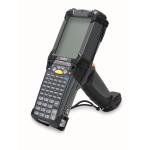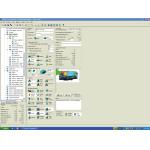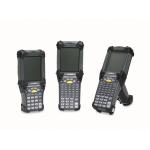Latest News
May 1, 2006
By Russell Shuba
Symbol cuts costs and time by overhauling its mobile devices with design for manufacture and assembly software.
Symbol Technologies creates devices that capture, manage, and communicate information over networks. It makes bar-code scanners, radio frequency identification (RFID) systems, and mobile handheld computers used in a wide variety of industries.
“Our products are at work nearly everywhere you go,” says Chris Foley, the manufacturing process engineer at Symbol, which is located in Holtsville,New York. “They’re checking out purchases and stocking storerooms. They’re monitoring luggage and tickets inside airports, and they’re tracking returned rental cars in the parking lots. They’re even scanning tickets at Mets games.”
Symbol’s products are subject to strict regulation and security requirements set by the credit and banking industries. They must also endure being handled hundreds or thousands of times a day without failing, often in challenging environments. “Our products have to pass a battery of environmental and other physical tests,” Foley says. “We drop them, we tumble them, we spray them with water, we zap them with electricity.” Symbol even tests its products on equipment designed to simulate the rigors of shipping on a delivery truck.
|
|
| The MC9000 from Symbol Technologies. |
› › The MC9000 is available in a number of customized options. The redesigned product had to offer the same form factors as the old model. Also, the company wanted to standardize the assembly process for various customized options as much as possible. To accomplish that, engineers emphasized part count reduction and shorter assembly times. Click to enlage.
With all these performance requirements, it’s tempting to overengineer, but Symbol has begun to actually reduce part counts on existing designs by using Design for Manufacturing and Assembly (DFMA) software from Boothroyd Dewhurst.
“We’re looking to reduce cost, cut assembly times, and improve quality, all at the same time,” Foley says. “We can do all that by reducing the number of parts in our assemblies.”
In one recent redesign project, for example, Symbol was able to reduce the part count of its MC9000 mobile device by 20 percent and to cut assembly labor time of the device by 17 percent.
Redesigning the MC9000
The MC9000 is a rugged, handheld device that includes a scanner, a small computer, and a wireless transmitter for sending data over a local area network or a wide-area cellular network to a main computer. The MC9000 provides real-time information to companies in shipping, retail, manufacturing, and other businesses.
Like many Symbol products, the MC9000 is available in a number of customized options. The redesigned product had to offer the same form factors as the old model because it represented a considerable installed base in the field. It also had to be compatible with existing accessories, use the same batteries, and incorporate the same key service features. But engineers were charged with standardizing the assembly process for the new version’s customized options as much as possible. As part of that process, engineers hoped to reduce part count and shorten assembly times.
The design team was cross-functional and included mechanical, electrical, and process engineers. The team followed a well-documented product development path that is a part of a larger product lifecycle management (PLM) program. “The company uses any number of metrics for PLM, including costing and scheduling,” says John Wick, manufacturing process engineer at Symbol. “DFMA analysis is our most important design metric tool.”
Regular Analyses
At Symbol, DFMA analyses occur at three formal stages: concept, critical, and final design reviews. In addition, less formal DFMA analyses occur whenever a team member proposes a revision. On the MC9000 design, that happened several times weekly. Wick notes, “If an engineer asked, ‘What happens if we get rid of these two screws?’ the analyses helped us to answer that question.”
|
|
| DFMA software from Boothroyd Dewhurst. |
› › View of the MC9000 analysis in DFA 9.0 software from Boothroyd Dewhurst. The software displays in a single main window all three components of the DFA analysis process: the Product Structure Chart, the DFA Questions Panels, and the Results Box. Design engineers can customize the panels they wish to view and proceed quickly through DFA analysis without leaving the main window.
Engineers began by using DFMA to list all part and assembly information of the existing MC9000 design and answered questions about every part, evaluating the assembly processes each part underwent. The software then generated a report that included the total number of parts and assembly times.
Then they reviewed the part list to decide whether individual items were necessary. “That’s not as simple as it sounds,” Wick admits. “MC9000 had one printed circuit board for its main functionalities and another for different customer options. When we started the redesign, both boards seemed necessary.”
| MC9000 DFA Results |
| Current | Final Review of | Percent | |
| Number of | 96 | 77 | 20% |
| Estimated | 1038 | 865 | 17% |
But were they? The more the group explored the benefits of placing the standard and optional components on a single board, the more attractive the advantages became. It would trim the part count, cut cables and cable routing distances in an already-crowded unit, promote easier assembly, and make the entire unit more rugged by reducing and simplifying connections.
The team created a design for a single board, placing certain features near the interconnecting connector on the board to shorten both cable length and assembly times. The increased free space inside the unit further reduced assembly times. Wick recalls, “We ran the first DFA report for the new design and we looked at the time savings and said, ‘Wow.’”
The engineers picked up more savings during the critical design review. They found that the main chassis was protected by a rubber shock-absorbing system consisting of four parts, three of which had been added on in separate design reviews after mechanical testing. The analysis suggested that the four parts could be combined into one. “That’s a good example of why it is worth analyzing the whole product design again when you want to add a part,” Wick points out.
Payoff in Parts
During the final review, the team entered the entire new bill of materials into DFMA. The software then generated a report showing the parts and estimated labor time in seconds. The comparison was striking (see Table above): the new design reduced part count by 20 percent and assembly labor time by 17 percent.
|
|
| The MC9000 family |
The MC9000 tested well and is in preproduction. It is expected to achieve assembly time and cost savings in line with those predicted by the DFMA analysis.
Symbol will continue to require DFMA analyses in all its product development. The company is also introducing the software at its OEM partners, who design and manufacture Symbol products at their own sites. “We manage and oversee product development at our partners,” Wick says. “Eventually, we want DFMA to be a part of their design process as well.”
Russell Shuba is a freelance writer who lives outside Madison, WI. When he’s not tracking down the details of his latest assignment, he can be found plying the north country’s lakes in a homemade kayak. To comment on this article, send us an e-mail by clicking here. Please reference “Design Performance, June 2006” in your message.
Company Information
DFMA
Boothroyd Dewhurst, Inc.
Wakefield, RI
MC9000
Symbol Technologies
Holtsville, NY
Subscribe to our FREE magazine, FREE email newsletters or both!
Latest News
About the Author
DE’s editors contribute news and new product announcements to Digital Engineering.
Press releases may be sent to them via [email protected].









